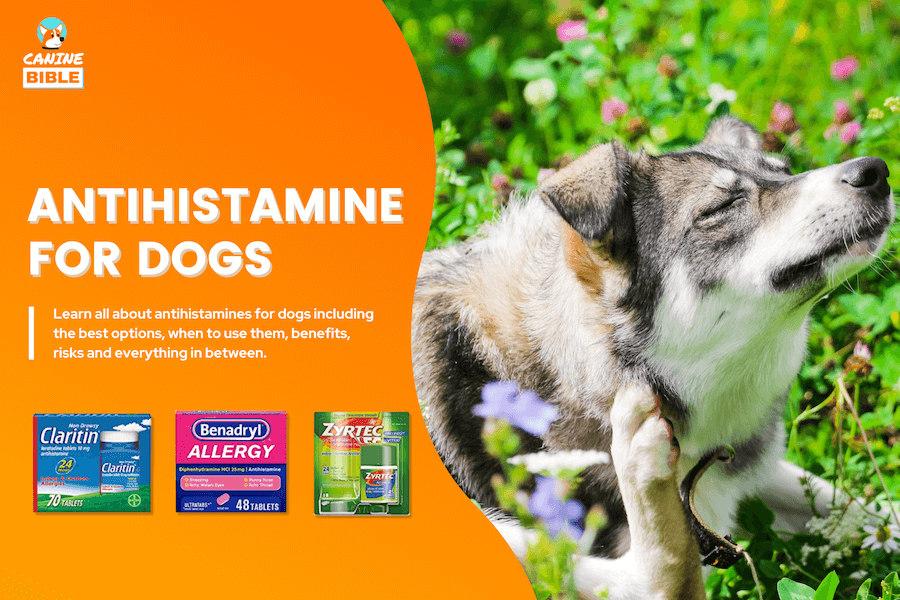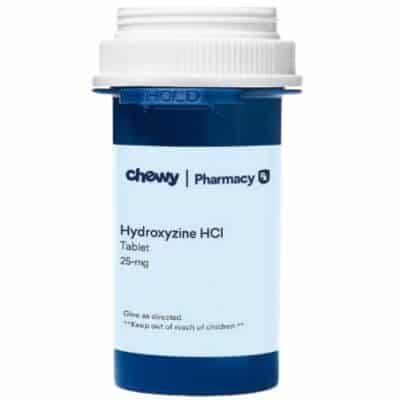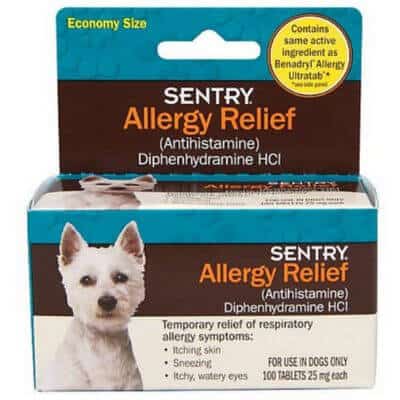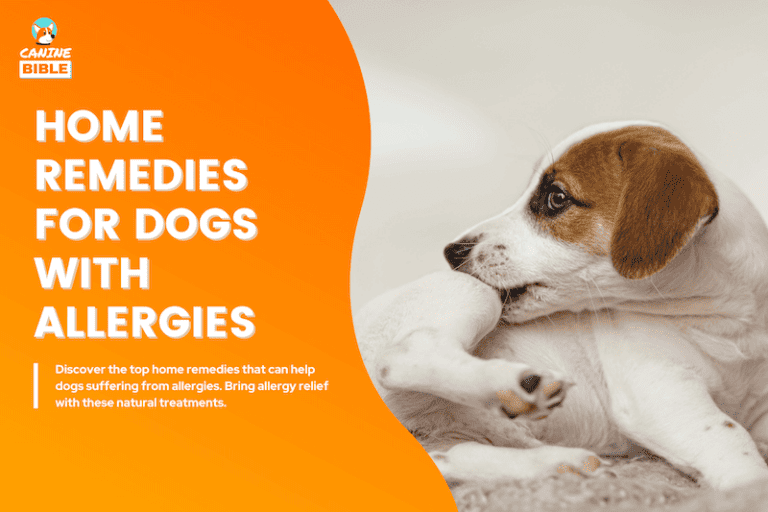Best Antihistamines For Dogs: Benefits, Dose, Risks & More

Canine Bible is reader-supported. We receive affiliate commissions via some of our links. This doesn’t affect rankings. Learn more.
Dog owners know the struggle of dealing with a pup who’s constantly itching, scratching, and sneezing. After extensive research and consultation with veterinarians and studies, our research team found the best antihistamines for dogs to relieve their allergies. But with so many options on the market, how do you know which antihistamine is right for your pup? Well, we’ve got you covered with a breakdown of the most effective antihistamines treatment for dogs, their benefits, potential side effects, when to use them, why brands are better for specific allergies and everything in between. Let’s get started!
Best Antihistamines For Dogs — At A Glance
Scroll to the right to see all our recommendations for the best antihistamines for dogs.
What Are Antihistamines For Dogs?
Antihistamines are medications designed to help reduce allergy symptoms by blocking the effects of histamines. Histamines are chemicals your dog’s immune system releases in response to an allergen. Various factors, including environmental allergens such as pollen, dust mites, mold spores, and food allergens, can cause dog allergies. Numerous antihistamines are available for use in dogs, both over-the-counter and prescription-based.
Types of Antihistamines
Popular Antihistamines For Dogs
Here are some of the most commonly used antihistamines to help your dog battle allergies.
| First Generation | Second Generation |
|---|---|
| Diphenhydramine (Benadryl, Sentry, PetArmor) | Cetirizine (Zyrtec) |
| Hydroxyzine (Atarax, Vistaril) | Loratadine (Claritin, Alavert) |
| Chlorpheniramine (Chlor-Trimeton) | Fexofenadine (Allegra) |
Which Generation Of Antihistamie Is Better For Dogs?
As the name suggests, first-generation antihistamines were the initial type to be approved by the Food and Drug Administration (FDA). Their approval in the United States began in the 1930s and continues to be prescribed today.
These antihistamines act on histamine receptors in the brain, spinal cord, and other receptors. A notable characteristic of this generation of antihistamines is their ability to cross the blood-brain barrier, which leads to drowsiness.
The FDA approved second-generation antihistamines, which entered the market in the 1980s. Unlike first-generation antihistamines, second-generation ones do not cross the blood-brain barrier to the same extent and therefore do not cause drowsiness at standard dosage levels. As a result, second-generation antihistamines are considered safer than their first-generation counterparts due to their reduced propensity for causing drowsiness and fewer drug interactions.
When Should Antihistamines For Dogs Be Used?
Antihistamines for dogs should only be used under the guidance of your veterinarian.
Vets may recommend antihistamines as the first line of treatment for dog allergies for a few reasons:
However, it’s important to note that not all dogs respond well to antihistamines, which may not be effective for all allergies. If your dog’s allergies are severe or persistent, or the antihistamine isn’t providing sufficient relief, your vet may recommend other medications, such as corticosteroids, immunosuppressive drugs, or allergen-specific immunotherapy.
Always consult with your veterinarian before administering any medication to your dog, as the appropriate treatment will depend on the specific cause and severity of the allergy.
Can Dogs Take Antihistamines?
Yes, dogs can take antihistamines, but it’s essential to consult with a veterinarian before administering them to your pet.
Some antihistamines are safe and effective for healthy adult dogs as part of a treatment plan to address canine allergies. However, not all antihistamines work for every dog, and their effectiveness varies depending on the individual dog. This means you may need to try several antihistamines under your vet’s guidance to find one that works for your pet.
If your dog is prescribed antihistamines, it’s essential to try them for 2-3 weeks to evaluate their effectiveness. If they don’t help, consult your vet about trying another antihistamine. Remember that antihistamines may not completely solve your dog’s allergies.
Remember, antihistamines are inappropriate for emergencies, such as during a life-threatening allergic reaction. Studies have shown that antihistamines are only effective between 25% to 54% of the time.[1]
A study at the Veterinary Medical Teaching Hospital of the University of California, where 178 of 271 dogs with atopic dermatitis were prescribed antihistamines, revealed that only 54% of dogs given antihistamines responded favorably to these treatments, with 27% of the responses rated as good and 27% rated as moderate.[2] However, anecdotal evidence and survey research suggest antihistamines are good dog allergy relief options.[3]
Benadryl (diphenhydramine) is the most popular. Other safe antihistamines for dogs include Claritin (Loratadine) and Zyrtec (cetirizine).
And because dogs exhibit varying reactions to different antihistamines, if your dog has not seen any improvements after two weeks, you need to try other antihistamines before determining their effectiveness in your dog.
Dog Antihistamine Benefits
Over-the-counter (OTC) antihistamines can help treat symptoms such as:
Antihistamine Side Effects On Dogs
Antihistamines are usually safe but can make some dogs drowsy and others hyperactive. As with any drug, there is always a chance of side effects.
Some of the common side effects of first-generation antihistamines include:
Some of the common side effects of second-generation antihistamines include:
Other Risks
It’s important to note that not all over-the-counter antihistamines are safe for dogs. While Benadryl, Claritin, and Zyrtec are antihistamines typically safe and recommended by vets, some may contain added decongestants, which can be harmful to canines.
The most common types of decongestants are pseudoephedrine and phenylephrine. These drugs are commonly found in allergy medications. Antihistamines like Contac, Actifed, Sudafed, Tavist-D, Claritin-D, or any other brand antihistamine with “D” added to the name are best avoided. The “D” indicates the medicine contains a decongestant, but always read the labels carefully before administering any OTC pills to your pets and do so at your vet’s discretion. According to the Pet Poison Helpline, decongestants can be deadly in dogs. They can result in vomiting, dilated pupils, severe blood pressure changes (hypertension), abnormal heart rhythms and rates, tremors, and seizures.[4]
Antihistamines can also interfere with other medications, vitamins, supplements, or herbal remedies that your dog may be taking. It’s key to tell your vet about everything your dog is taking.
If your dog experiences any adverse reactions or if the allergy symptoms persist or worsen, it’s essential to contact your veterinarian immediately.
Best Over The Counter Antihistamine For Dogs
Whether you need the best antihistamine for dogs with skin allergies, itching, or other allergy symptoms, these are your top options.
PRO TIP: Use peanut butter, pill pockets, or some other trick to get your dog to take antihistamine tablets, as they are a bit bitter.
Best Overall Antihistamines For Dogs — First Generation

Benadryl (also known as diphenhydramine) is considered safe for dogs and cats and is commonly used in veterinary clinics nationwide. Know that Diphenhydramine is a first-generation ethanolamine-derivative antihistamine. This class of antihistamines can cross the blood-brain barrier, leading to their high effectiveness and increased side effects than other antihistamines. The American Kennel Club says that if your dog suffers from mild-to-moderate allergies, Benadryl is a great medication to use.[5]
Benadryl for dog allergies works by blocking H1 receptors to keep histamines at bay, reducing symptoms of allergies. Jessica Vogelsang, DVM at PetMD, says the drug is “well-tolerated and has a wide safety margin” for use on dogs. Vets normally recommend it for environmental allergies, allergic reactions to insect bites or stings, and other common dog allergy symptoms like sneezing, hives, and itchiness. Benadryl typically provides faster relief than other antihistamines.
Benadryl has sedative properties, so your dog could get very drowsy. Some Benadryl formulas contain Xylitol, which is deadly to dogs. Avoid formulas with dyes. You may also want to stick to the children’s formula of Benadryl, as the adult version contains alcohol, which is toxic to dogs.
Dog Dosage
The correct dosage of Benadryl for dogs depends on the dog’s weight. But, generally, vets recommend 1 milligram per pound of body weight, given twice daily. For easier dosing, you can use the liquid formula of Benadryl. It’s easier to measure.
Precautions
Benadryl is not advised to use on dogs with high blood pressure, seizures, bladder issues, lung disease, or glaucoma. It may negatively interact with other medications.
Best Antihistamines For Dogs — Second Generation

The best thing about Claritin is that it’s a “second-generation” antihistamine, so it doesn’t usually cause drowsiness as “first-generation” antihistamines like Benadryl. Claritin is the most potent medication in the class, which has made it the go-to choice for doctors and veterinarians.
Loratadine does not cross the blood-brain barrier and does not cause drowsiness. It also is much longer-lasting than some of the classic antihistamines in use.[6] Always check the label on the Claritin. Some versions (Claritin D) are made with pseudoephedrine, a decongestant. Decongestants are highly toxic to dogs, so you’ll want to avoid such formulations. Claritin also comes in a quick-dissolve form, but that may contain Xylitol, which is poisonous to dogs.
The safest option is the original Claritin product. The regular children’s formula is also safe, but you must adjust the dosage accordingly. It comes in tablet and liquid form; either is good. Like all antihistamines, Loratadine blocks the effects of histamine in the body, thus blocking the allergic reaction.
Dosage
Give approximately 0.1 to 0.5 milligrams/pound of body weight once to twice daily.
Precautions
Loratadine can be given with or without food. Because Loratadine has been known to decrease tear production in humans, use it with caution in dogs with dry eyes. Ketoconazole (an antifungal) and erythromycin (an antibiotic) increase loratadine levels with concurrent use. Do not use these medications together.
Best Antihistamines For Dogs With Skin Allergies

Zyrtec for dogs is a popular prescription for canines suffering from allergic reactions like itchy skin, and it doesn’t have the effect of leaving your pet sedated and lethargic.[7] The active ingredient in Zyrtec is cetirizine, which veterinarians deem safe when administered appropriately. Unlike Benadryl, drowsiness with Zyrtec is often very rare. Research shows that oral cetirizine prevents cutaneous allergic reactions without any apparent adverse effects in dogs.[8]
Patty Khuly, DVM from PetMD, says Zyrtec seems to help quite a bit, far more than Benadryl’s Diphenhydramine. One study of dogs with atopic dermatitis found that Zyrtec reduced itching in 18% of the dogs studied. According to a more successful study with a 100% efficacy rate, dogs who consumed Zyrtec before receiving histamine injections had less inflammation around the injection site than those who did not. A separate study found that the active ingredient in Zyrtec was notably more effective than Benadryl at minimizing the body’s immune response.[9][10]
Never, ever use Zyrtec-D. It contains pseudoephedrine, a decongestant incredibly harmful to dogs and can cause high blood pressure, seizures, and even death.
Dosage
Generally, a dose of Zyrtec for dogs is determined by their size and the allergy being treated. Approximately 0.5 mg/pound of body weight is normally recommended, given once to twice daily. However, always ask your vet.
Precautions
Dogs struggling with kidney or liver problems could worsen symptoms if given Zyrtec. Nursing or pregnant dogs should not consume Zyrtec. The medication can be passed onto puppies through the mother’s milk. Never give Zyrtec to dogs allergic to antihistamines, especially those with cetirizine or Hydroxyzine. This may cause a life-threatening reaction called anaphylactic shock.
Best Dog Specific Antihistamine — PetArmor Antihistamine

PetArmor Antihistamine is an over-the-counter medication designed to help relieve allergy symptoms in dogs. It contains Diphenhydramine, the same active ingredient found in Benadryl. Diphenhydramine is a first-generation antihistamine that works by blocking the effects of histamine in the body, which can help to reduce symptoms such as itching, sneezing, and runny nose. PetArmor typically comes in tablets or liquid, which can be easily administered to your dog.
Honorable Mention — Sentry Allergy Relief For Dogs
Sentry is another Antihistamine available for dogs. Sentry allergy relief dog tablets contain the same active ingredient as Benadryl (Diphenhydramine HCl), which is essentially the same under a different brand name.
Best Prescription Antihistamine For Dogs
Hydroxyzine For Dogs
Can I give my dog Hydroxyzine? Yes. While less commonly used because a prescription is needed, Hydroxyzine is one of the most effective antihistamines available for dogs. Common brand names for Hydroxyzine are Atarax (Hydroxyzine HCl) and Vistaril (Hydroxyzine pamoate). It can treat all common allergic conditions. It usually takes effect quickly, in about 1 to 2 hours, and improvement in clinical signs should follow.
Dosage
Dosing is similar to Benedryl at 1mg per pound body weight two times daily. Talk to your vet.
Dog Antihistamine Dosage Chart
This dog antihistamine dosage chart provides the most common dosages prescribed.
| Antihistamine | Dosage | Frequency |
|---|---|---|
| Benadryl | 1 milligram/pound | 2 times per day |
| Claritin | 0.1 to 0.5 milligram/pound | 1 to 2 times daily |
| Zyrtec | 0.5 mg/pound | 1 to 2 times daily |
| Hydroxyzine | 1 milligram/pound | 2 times per day |
| Sentry | 1 milligram/pound | 2 times per day |
Natural Antihistamine For Dogs
While there are no true natural antihistamines, certain natural remedies and supplements can help alleviate allergy symptoms in dogs. Some options include:
Always consult your veterinarian before introducing natural remedies or supplements to your dog’s diet.
Dogs That Should Not Take Antihistamines
If your dog suffers from any of the following conditions, antihistamines might not be safe for them.
Never try to treat your dog without the help of your vet because you might make them even sicker.
Antihistamine For Dogs Frequently Asked Questions
Here are the most commonly asked questions about antihistamines and dogs.
Best Antihistamine For Dogs — Conclusion
Based on our research and scientific evidence, Hydroxyzine is the best antihistamines prescription option for dogs. The best OTC antihistamine for dog allergies is Benadryl and Claritin. Zyrtec is recommended for skin allergies.
Hydroxyzine and Zyrtec (Cetirizine) have demonstrable anti-histaminic action in the dog and should be the preferable antihistamine in this species, says the International Task Force on Canine Atopic Dermatitis.
For optimal efficacy, antihistamines should be used as preventatives, and they should preferably be given continuously daily. If antihistamines don’t work for your dog, it’s time to consider another treatment option. You can also get ahead of the allergy by performing a dog allergy test to avoid allergy symptoms altogether.
Dealing with allergies can be a challenging experience, but knowing how and when to use an antihistamine for dogs can make all the difference. Taking a proactive approach is the best medicine for treating dog allergies.
Like It? Subscribe & Share!
Canine Bible authorship represents the unified voice of our entire editorial team and our in-house veterinarians rather than a single author. Each article, blog post, and review published under the Canine Bible name undergoes a rigorous review process, involving all team members to guarantee accuracy and up-to-date in accordance with the latest veterinarian research. This collaborative effort is an integral part of our editorial process and aligns with our four pillars of content creation. This approach ensures our content is backed by expert knowledge and factual information, offering our readers reliable, actionable, and trustworthy content.








![Dog Allergy Testing Cost: How Much Will You Pay? [Update 2024]](https://www.caninebible.com/wp-content/uploads/2022/08/how-much-does-dog-allergy-testing-cost-768x512.jpeg)




